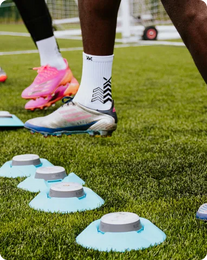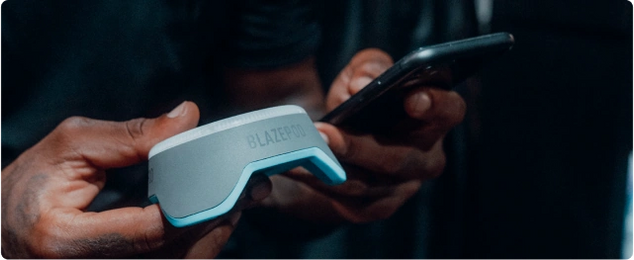Physical therapy rehabilitation is essential for anyone bouncing back from an injury, whether you’re a seasoned athlete or someone looking to regain normal function after a mishap.
Physiotherapy, often called physical therapy, plays an important role in this recovery process. It focuses on restoring movement and function, reducing pain, and preventing further injury. Physiotherapy exercises are specifically designed to strengthen muscles, improve flexibility, and enhance dexterity, making them a vital part of any recovery plan.

From simple stretching routines to more advanced strength training, physical therapy exercises cater to all fitness levels and recovery stages. These exercises are not just about physical recovery; they also boost confidence, getting you back to your peak performance in no time.
BlazePod assists individuals on their recovery journey by providing interactive, light-based exercises that improve reaction time, coordination, and cognitive function. These exercises are customizable, making them suitable for various stages of injury recovery, helping users regain strength, boost mobility, and boost overall physical performance. By keeping training engaging and data-driven, BlazePod ensures that users remain motivated, consistently progressing, and gaining confidence throughout their rehabilitation process, ultimately getting back to peak performance in no time.
We are diving into various;physical therapy exercises that are particularly effective for injury recovery. Whether you’re dealing with a sports-related injury or a slip-and-fall, these exercises, combined with BlazePod’s interactive training, will help you regain your strength and mobility. Let’s get started on the road to recovery!
Functional Training
Functional training is all about improving your body’s ability to perform everyday activities efficiently and safely. By focusing on movements that mimic real-life actions, functional training amplifies your strength, balance, and flexibility, making it essential for rehabilitation.
Think of it as training that not only helps you recover faster but also makes you stronger and more resilient in your daily life. Whether you’re a trainer, athlete or just your average Joe, incorporating these exercises can significantly boost your recovery and overall performance.
BlazePod Kickthroughs
Using our bodies in different challenging ways builds resistance for functional uses and aids us while we recover from an injury. This approach advances overall strength, flexibility, and physical precision, preparing the body for diverse real-life movements. By targeting various muscle groups and improving balance, like in the BlazePod Kickthroughs drill, you can accelerate recovery and prevent future injuries.
Set up six Pods on the floor in two rows of three, with 1-2 meters between the rows and 50 cm between the Pods in the same row. Start in a crawl position, with your hands and feet touching the floor between the two rows of Pods. Throughout the drill, only your hands and feet should touch the ground. When a Pod lights up, turn your body and kick the leg furthest from the lit Pod under your body, tapping the Pod with the heel of your foot. Return to the starting position and repeat, keeping your core strong and engaged throughout.
Core Rotation
Using our core for functional exercises is crucial in injury recovery training as it stabilizes the body, enhances balance, and supports overall movement. A strong core reduces strain on other muscles and joints, promoting a more efficient and safer recovery process.
For the Core Rotation drill on the BlazePod app, place four Pods in a semicircle, each 50 cm apart. Sit facing the Pods, with your feet between the top two and knees up. Lean back slightly to engage your core. When a Pod lights up, keep your body anchored and tap it with the opposite hand - if the left Pod lights up, tap it with your right hand.
Strengthening Exercises
Strength training exercises help rebuild muscle strength, improve joint stability, and refine overall function, making daily activities easier and more comfortable. It’s also the ideal way to keep yourself strong in the off-season, without overworking when you’re not at peak performance.
By targeting specific muscle groups weakened by injury, strength training aids in restoring balance and preventing future injuries. Using resistance bands, weights, or bodyweight exercises in your routine can accelerate recovery and boost your confidence.
Around the World Challenge
Bosu balls are an excellent tool for strengthening post-injury, providing a low-impact way to build muscle and improve stability without overdoing it. Try the ‘Around the World Challenge’ to elevate your balance and core strength while keeping your workouts engaging and effective.
Place four Pods around a Bosu ball in a square formation, with each Pod 2 meters away from the ball. Start the drill with one foot on the center of the balance ball, and the other foot on the ground. When a Pod lights up, keep your foot on the balance ball and shuffle around to the Pod. Tap it out, and move to the next light as quickly as you can. Tap each Pod out as fast as you can, and ensure that your foot doesn’t break contact with the ball.
Add a second color to add a more complicated, cognitive element to the exercise. When the first Pod lights up, move forward to tap out the Pod, if the second color lights up, move backwards to tap out the Pod.
Plank Step
As terrible as they may feel, planks strengthen the core muscles, enhance stability, and support proper posture; majorly important on the road to injury recovery. Enter the ‘Plank Step’. This drill not only strengthens your core but also enhances your motor skills and stability, essential for injury recovery.
Begin by placing two Pods on the ground under your chest, aligned with each knee, and another two Pods one meter away from each side of your body, aligned with your ankles. Assume a plank position with your shoulders above your hands and your core engaged. Hold this plank throughout the entire activity. When a Pod lights up under your chest, tap it out with the closest knee. If a Pod lights up near your ankles, tap it out with the nearest foot.
Flexibility and Stretching Exercises
Flexibility and stretching exercises are a crucial component of;physical therapy rehabilitation for injury recovery. These activities help upgrade your range of motion, reduce stiffness, and prevent scar tissue buildup, ensuring smoother and quicker healing.
Adding regular stretching into your routine can alleviate pain and increase blood flow to the injured area, promoting faster recovery. Plus, it’s a great way to prepare your body for more intense strengthening exercises later on.
Walk Out Press Up
Gradual movements and exercise stretching enhance flexibility, promote blood flow, and reduce stiffness; making them the perfect way to ease back into our exercise routine. These exercises, just like our next recommended drill ‘Walk Out Press Up,’ help restore range of motion and ensure a safe transition back to regular physical activity, pushing us to a more long lasting recovery process.
Set up by placing four Pods in a line on the ground, with 20 cm between each Pod. Stand one meter back from the first Pod. When a Pod lights up, place both hands on the floor, walk your hands out to the lit Pod, perform a press-up, tap it, and walk your hands back to stand up straight. Repeat this sequence every time a Pod lights up.
Core Clock
Never underestimate the importance of multitasking; or the ability to do two things at once. It boost coordination, elevates cognitive function, and helps build neural pathways that enable better movement control. By training exercises that force you to multitask, you can accelerate recovery through engagement of the mind and body simultaneously.
For the ‘Core Clock’ drill, position four Pods in a semi-circle on the floor in front of you, spaced 50 cm apart. Sit on the floor with your legs straight out in front, holding a medicine ball or similar weight above your head. When a Pod lights up, move the closest leg up and over the lit Pod, returning to the starting position while keeping your leg and body as straight as possible.
Balance Exercises
Balance exercises are a vital part of;physical therapy rehabilitation for injury recovery, as they help restore stability and prevent future injuries. These exercises focus on developing your body’s ability to maintain control and coordination, essential for daily activities and sports performance.
By incorporating balance training into your rehabilitation routine, you can enhance proprioception, strengthen stabilizing muscles, and reduce the risk of falls or re-injury.
One Leg Balance
Not only will balancing on one leg bring out the kid in you, it is actually an essential part of injury recovery and our overall well-being. It strengthens stabilizing muscles, improves dexterity, and helps prevent future injuries. So, we recommend trying your hand at the ‘One Leg Balance’ drill.
Arrange the Pods in a square on the floor, with one meter between each of them. Stand in the center of the square and raise one leg in the air. When a Pod lights up, tap it with your raised foot and look for the next Pod to light up. Continue this until the activity ends, without letting your raised foot touch the ground. Focus on maintaining balance rather than speed.
Bend Over Bosu Challenge
Improve physical health, strengthen your core, flexibility, and stability by balancing while bending down. By practicing this skill, ensure you can perform everyday tasks with ease and confidence, reducing the risk of injuries. Try the ‘Bend Over Bosu Challenge’ to test and upgrade your skills.
Grab a Bosu ball and set 4 Pods 20 cm apart in front of it. Get ready to move fast but carefully – the Pods will light up one by one, forcing you to tap each one as quickly as possible before time runs out. Don't be fooled by its simplicity; the Bosu ball adds a new dimension, pushing your balance, core strength, and focus to the limit. This 30-second drill will fly by, and fatigue sets in quickly.
Conclusion
Incorporating functional training, strengthening, flexibility, stretching, and balance exercises into your recovery plan is key to bouncing back stronger and more resilient. These exercises not only help rebuild your body but also keep you motivated throughout the process. Embrace these routines to accelerate your recovery and ensure long-term success in maintaining your physical health.























